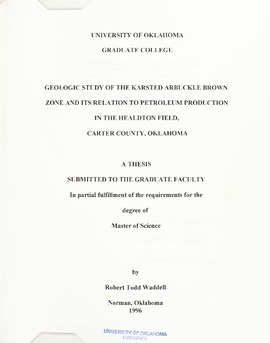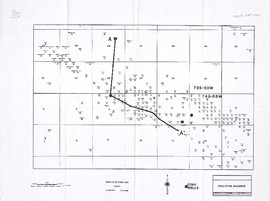| dc.contributor.author | Waddell, Robert Todd | |
| dc.date.accessioned | 2017-02-20T23:39:04Z | |
| dc.date.available | 2017-02-20T23:39:04Z | |
| dc.date.issued | 1996 | |
| dc.identifier.uri | https://hdl.handle.net/11244/48337 | |
| dc.description.abstract | The Arbuckle Group has a gross thickness in excess of 10,000 feet in the southern Oklahoma aulacogen. The Healdton field, located within the southern Oklahoma aulacogen, has produced over 12 million barrels of oil from the upper Arbuckle. Cumulative production records attribute approximately 95% of all Arbuckle production within the Healdton field to the Brown zone. The thesis problem is to determine why the Brown zone is the most prolific hydrocarbon producer within an 8,000 to 10,000 foot carbonate section and how to explore for areas with similar reservoir development. | |
| dc.description.abstract | The Brown zone in the Healdton field underwent extensive replacement dolomitization, while the overlying Wade and Bray zones retained their original limestone depositional fabric. A stratigraphic variation exists between the Healdton field and the Shell Chase #1-28 well, approximately 2 miles to the north. The stratigraphic equivalent of the Brown zone in the Chase well is a black carbonate mud, indicating it was deposited in a deeper and quieter water environment than that of the Healdton field. An isopach thinning was found over the Healdton field between the top of the Bray and the top of the Brown zone, indicating paleotopography played an important role in the development ofthe initial facies, and subsequent dolomitization. | |
| dc.description.abstract | The Brown zone has major karst development, but the Wade and Bray do not. No karst was observed in the stratigraphic equivalent of the Brown zone in the Shell Chase well either. Karst development is closely tied to dolomitization. The Brown zone had opportunities for both meteoric and deep burial karst development. Some studies cite lack of faunal evidence in support of a pre-Simpson shallow burial karst, however geochemical studies cite evidence of higher temperatures indicating deep burial karst. Baroque dolomite, usually an indicator of hydrothermal fluids, was found throughout the Brown zone core examined in this study. Combined evidence suggest that the majority of the karst development in the Brown zone occurred during deep burial and exposure to basinal fluids. | |
| dc.description.abstract | The sequence of events for the development of the Brown zone dolomite are proposed as follows: ( 1) replacement dolomitization soon after deposition, (2) subsidence and exposure to basinal fluids, (3) deep burial karst development, (4) uplift of the Healdton field structure in the Morrowan, (5) collapse of dolomitic karsted reservoir, (6) subsequent deposition of pore rimming baroque dolomite, and (7) hydrocarbon migration. | |
| dc.description.abstract | Dolomitization is the key to Arbuckle reservoir development. It served as the conduit for all subsequent diagenetic fluids. Dolomitization also serves to significantly increase the fracture potential, thereby increasing the fracture network during tectonic movement. | |
| dc.language | en_US | |
| dc.subject | Karst--Oklahoma--Arbuckle Mountains | |
| dc.subject | Geology--Oklahoma--Arbuckle Mountains | |
| dc.subject | Oil fields--Oklahoma--Healdton | |
| dc.title | Geologic Study Of The Karsted Arbuckle Brown Zone And Its Relation To Petroleum Production In The Healdton Field, Carter County, Oklahoma | |
| dc.type | Thesis | |
| dc.date.manuscript | 1996 | |
| dc.thesis.degree | Master of Science | |
| dc.note | Accompanied by three illustrations. | |
| ou.group | Geology and Geophysics, School of | |

